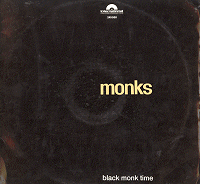|
REVIEWS
|
black
monk
time
|
 |
Review
of BLACK MONK TIME by Tad Hendrickson from CMJ New
Music Report Issue: 513 - Mar 17, 1997
Jaded
by life as a hard touring rock 'n' roll band of ex-army
serviceman living in the Germany of the '60s, the
Monks were a big fat bummer amidst the onslaught of
crazed '60s German beat music. Wearing black monks'
robes and shaving bald spots into the top of their
heads, they just didn't fit in with the German scene.
They did, however, take inspiration from fellow miscreants
the Pretty Things and The Who to try to do something
different. Their solution was to explore the darker,
more primal, side of life. Wanting their music to
reflect this, the Monks made their songs short and
very direct, often with just a couple of lines of
lyrics. Similarly primal, the sound was a menacing
combination of volume, fuzzboxes and tribal-like drums.
This disc compiles the highly-sought-after Black Monk
Time LP and two singles, which represents the entire
discography for their two-year existence.

Review
of BLACK MONK TIME from SPIN: May, 1997
Mad
scientists and studio conceptualists have long known
that subtracting from a song can actually make it
rockk harder. Think of the Ramones, think of drum
'n' bass - how dumb can you make it before it sounds
def? And scientists of the mind have long noted just
how little of our brains we actually use. What unites
'60s proto-punk loonies the Monks and '70s punk artistes
the Urinals is that they used even less of their brains
than most of us. And as a result, they rocked like
Carl Sagan.
The Monks were five American soldiers doing their
duty in Germany; when their hitch was up they made
a go of it as a guitar army on the local "beat
club" circuit. Egged on by their German manager
to go for novelty, the Monks perhaps took him too
literally. "The idea," guitarist/singer
Gary Burger explains in the notes to Black Monk Time,
"was simplicity, repetitiveness, simple lyrics,
and don't make the song too long." The record
never recovers from the opener "Monk Time,"
an inflamed, incoherent statement of purpose that
wags its tail like a happy stegosaurus. It's shocking
to read that the band meant it as an antiwar protest.
Between the banjo and contradictory, raving lyrics,
what the song seems to be protesting is meaning itself.
The Monks' shaved heads and dark robes must have had
a special resonance in the land of Martin Luther.
They relished not being welcome. "You could find
the tension point in the audience, you could watch
them getting nervous," enthuses bassist Eddie
Shaw. Europeans were further confused when Polydor
released a Monks album in 1966; masterpieces like
"Higgle-Dy-Piggle-Dy" and "Blast Off!"
turn every instrument into a tool of rhythm. While
Paul Revere & the Raiders were still headlining
Portland bowling alleys, and before "(I'm Not
Your) Steppin' Stone" had even been composed,
the Monks were inventing a blitzkrieg bop far stronger
than what soon followed. "It wasn't just a rock
'n' roll band," Burger notes wistfully. Heck,
it wasn't even a rock 'n' roll band. This is found
art.

|